How to Upload Small Size Photo in Triple C Form and They Are Many More Things Are Printed

Printing is a process for mass reproducing text and images using a primary form or template. The primeval not-paper products involving printing include cylinder seals and objects such as the Cyrus Cylinder and the Cylinders of Nabonidus. The earliest known form of press equally applied to newspaper was woodblock printing, which appeared in China before 220 Advertisement for cloth printing. However, it would non be applied to paper until the seventh century.[1] Afterward developments in printing applied science include the movable type invented by Bi Sheng effectually 1040 Advertisement[2] and the printing press invented past Johannes Gutenberg in the 15th century. The engineering science of printing played a fundamental role in the evolution of the Renaissance and the Scientific Revolution and laid the material ground for the modern cognition-based economy and the spread of learning to the masses.[3]
History [edit]
Woodblock printing [edit]
Woodblock printing is a technique for printing text, images or patterns that was used widely throughout East asia. It originated in Red china in antiquity equally a method of press on textiles and afterwards on paper. As a method of printing on fabric, the earliest surviving examples from Red china appointment to before 220 A.D.
In Eastward Asia [edit]

The earliest surviving woodblock printed fragments are from China. They are of silk printed with flowers in iii colours from the Han Dynasty (before 220 A.D.). The earliest examples of woodblock printing on paper appear in the mid-7th century in China.
By the ninth century, press on newspaper had taken off, and the beginning extant consummate printed volume containing its appointment is the Diamond Sutra (British Library) of 868.[4] Past the tenth century, 400,000 copies of some sutras and pictures were printed, and the Confucian classics were in impress. A skilled printer could print up to 2,000 double-page sheets per day.[five]
Printing spread early to Korea and Japan, which also used Chinese logograms, only the technique was also used in Turpan and Vietnam using a number of other scripts. This technique and then spread to Persia and Russian federation.[6] This technique was transmitted to Europe by around 1400 and was used on paper for old main prints and playing cards.[7]
In Middle Eastward [edit]
Block press, called tarsh in Standard arabic, developed in Arabic Egypt during the 9th and tenth centuries, by and large for prayers and amulets. There is some bear witness to suggest that these print blocks made from non-woods materials, possibly tin can, pb, or dirt. The techniques employed are uncertain. Block printing later on went out of use in Islamic Timurid Renaissance.[8] The printing technique in Egypt was embraced reproducing texts on paper strips and supplying them in different copies to meet the need.[9] [10]
In Europe [edit]
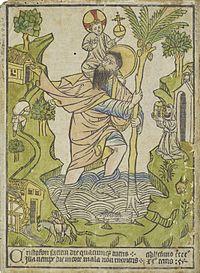
Block printing first came to Europe every bit a method for printing on cloth, where it was mutual by 1300. Images printed on cloth for religious purposes could exist quite large and elaborate. When newspaper became relatively hands available, around 1400, the technique transferred very apace to pocket-sized woodcut religious images and playing cards printed on paper. These prints produced in very big numbers from about 1425 onward.
Around the mid-fifteenth-century, block-books, woodcut books with both text and images, unremarkably carved in the same block, emerged every bit a cheaper alternative to manuscripts and books printed with movable blazon. These were all short heavily illustrated works, the bestsellers of the 24-hour interval, repeated in many different block-volume versions: the Ars moriendi and the Biblia pauperum were the most mutual. At that place is still some controversy among scholars as to whether their introduction preceded or, the majority view, followed the introduction of movable type, with the range of estimated dates beingness between about 1440 and 1460.[11]
Movable-blazon press [edit]
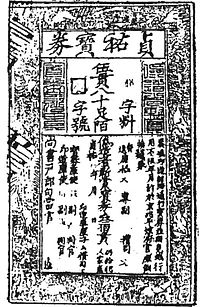
Copperplate of 1215–1216 5000 cash paper money with x bronze movable types

Movable type is the system of printing and typography using movable pieces of metal type, fabricated by casting from matrices struck by letterpunches. Movable blazon allowed for much more flexible processes than hand copying or block press.
Around 1040, the first known movable type system was created in Prc by Bi Sheng out of porcelain.[2] Bi Sheng used clay type, which bankrupt hands, just Wang Zhen by 1298 had carved a more durable type from wood. He also adult a complex system of revolving tables and number-association with written Chinese characters that made typesetting and printing more efficient. Still, the principal method in use at that place remained woodblock press (xylography), which "proved to be cheaper and more efficient for printing Chinese, with its thousands of characters".[12]
Copper movable type printing originated in China at the get-go of the 12th century. It was used in large-calibration printing of paper money issued by the Northern Song dynasty. Movable blazon spread to Korea during the Goryeo dynasty.
Effectually 1230, Koreans invented a metal type movable printing using bronze. The Jikji, published in 1377, is the earliest known metallic printed book. Type-casting was used, adapted from the method of casting coins. The character was cutting in beech wood, which was then pressed into a soft dirt to form a mould, and bronze poured into the mould, and finally the type was polished.[13] Eastern metal movable type was spread to Europe between the late 14th and early 15th centuries.[14] [15] [16] [17] [18] The Korean class of metallic movable type was described by the French scholar Henri-Jean Martin as "extremely similar to Gutenberg's".[xix] Authoritative historians Frances Gies and Joseph Gies claimed that "The Asian priority of invention movable type is now firmly established, and that Chinese-Korean technique, or a report of information technology traveled due west is well-nigh sure."[20]
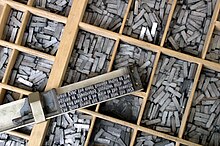
A case of bandage metal type pieces and typeset matter in a composing stick
The printing press [edit]
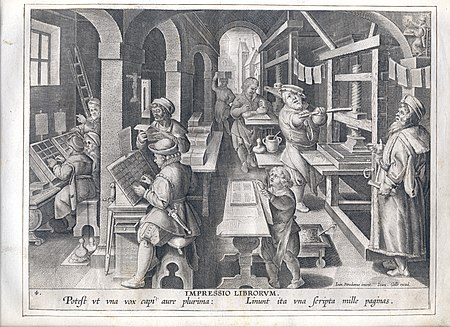
Around 1450, Johannes Gutenberg introduced the first movable type printing system in Europe. He avant-garde innovations in casting type based on a matrix and hand mould, adaptations to the screw-press, the apply of an oil-based ink, and the cosmos of a softer and more than absorbent paper.[21] Gutenberg was the outset to create his type pieces from an blend of lead, tin, antimony, copper and bismuth – the same components nevertheless used today.[22] Johannes Gutenberg started piece of work on his printing printing around 1436, in partnership with Andreas Dritzehen – whom he had previously instructed in gem-cutting – and Andreas Heilmann, the owner of a paper mill.[23]
Compared to woodblock printing, movable type folio setting and printing using a press was faster and more than durable. Also, the metallic type pieces were sturdier and the lettering more compatible, leading to typography and fonts. The high quality and relatively low price of the Gutenberg Bible (1455) established the superiority of movable blazon for Western languages. The printing press quickly spread across Europe, leading up to the Renaissance, and later all around the world.
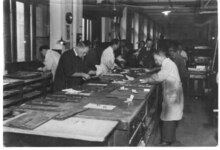
Folio-setting room – c. 1920
Gutenberg's innovations in movable type printing have been called the virtually important invention of the second millennium.[24]
Rotary printing press [edit]
The rotary printing press was invented by Richard March Hoe in 1843. Information technology uses impressions curved effectually a cylinder to impress on long continuous rolls of paper or other substrates. Rotary drum press was later significantly improved past William Bullock. There are multiple types of rotary printing printing technologies that are still used today: sheetfed offset, rotogravure, and flexographic printing.
Printing capacity [edit]
The tabular array lists the maximum number of pages which various press designs could print per 60 minutes.
| Hand-operated presses | Steam-powered presses | |||||
|---|---|---|---|---|---|---|
| Gutenberg-mode c. 1600 | Stanhope printing c. 1800 | Koenig press 1812 | Koenig press 1813 | Koenig press 1814 | Koenig press 1818 | |
| Impressions per 60 minutes | 200 [25] | 480 [26] | 800 [27] | one,100 [28] | two,000 [29] | 2,400 [29] |
Conventional press technology [edit]
All press procedure are concerned with 2 kinds of areas on the final output:
- Image expanse (printing areas)
- Not-prototype area (not-printing areas)
After the information has been prepared for product (the prepress step), each printing process has definitive ways of separating the image from the not-paradigm areas.
Conventional press has four types of process:
- Planographics, in which the printing and not-press areas are on the same plane surface and the departure between them is maintained chemically or past physical properties, the examples are: showtime lithography, collotype, and screenless printing.
- Relief, in which the printing areas are on a plane surface and the non printing areas are below the surface, examples: flexography and letterpress.
- Intaglio, in which the non-printing areas are on a plane surface and the printing surface area are etched or engraved beneath the surface, examples: steel die engraving, gravure, etching, collagraph.
- Porous or Stencil, in which the press areas are on fine mesh screens through which ink tin can penetrate, and the non-printing areas are a stencil over the screen to block the flow of ink in those areas, examples: screen printing, stencil duplicator, risograph.
Letterpress [edit]
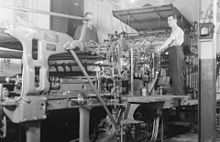
Miehle press press Le Samedi journal. Montreal, 1939.
Letterpress printing is a technique of relief printing. A worker composes and locks movable blazon into the bed of a printing, inks it, and presses newspaper confronting it to transfer the ink from the blazon which creates an impression on the paper. There is different paper for different works the quality of paper shows dissimilar ink to use.
Letterpress printing was the normal class of printing text from its invention by Johannes Gutenberg in the mid-15th century and remained in wide use for books and other uses until the second one-half of the 20th century, when offset printing was developed. More recently, letterpress printing has seen a revival in an artisanal grade.
Beginning [edit]
Start printing is a widely used modern printing process. This technology is best described as when a positive (right-reading) image on a press plate is inked and transferred (or "offset") from the plate to a rubber coating. The blanket epitome becomes a mirror epitome of the plate image. An offset transfer moves the paradigm to a printing substrate (typically newspaper), making the image right-reading again. Kickoff printing utilizes a lithographic procedure which is based on the repulsion of oil and water. The kickoff process employs a flat (planographic) image carrier (plate) which is mounted on a printing cylinder. The epitome to exist printed obtains ink from ink rollers, while the non-printing surface area attracts an (acidic) pic of h2o, keeping the non-prototype areas ink-complimentary. Most offset presses utilize three cylinders: Plate, coating, impression. Currently, most books and newspapers are printed using offset lithography.
Gravure [edit]
Gravure press is an intaglio printing technique, where the image being printed is made up of small depressions in the surface of the printing plate. The cells are filled with ink, and the excess is scraped off the surface with a doctor blade. And so a safety-covered roller presses paper onto the surface of the plate and into contact with the ink in the cells. The printing cylinders are ordinarily made from copper plated steel, which is subsequently chromed, and may be produced past diamond engraving; carving, or laser ablation.
Gravure press is used for long, high-quality print runs such equally magazines, postal service-society catalogues, packaging and printing onto fabric and wallpaper. Information technology is also used for printing postage stamps and decorative plastic laminates, such every bit kitchen worktops.
Flexography [edit]
Flexography is a type of relief printing. The relief plates are typically made from photopolymers. The procedure is used for flexible packaging, corrugated board, labels, newspapers and more than. In this market it competes with gravure printing by holding lxxx% of the market in United states, 50% in Europe but only twenty% in Asia.[30]
Other printing techniques [edit]
The other meaning printing techniques include:
- Dye-sublimation printer
- Inkjet, used typically to impress a small number of books or packaging, and also to impress a multifariousness of materials: from high quality papers simulating offset printing, to floor tiles. Inkjet is also used to apply mailing addresses to straight mail pieces
- Laser printing (toner printing) mainly used in offices and for transactional printing (bills, depository financial institution documents). Light amplification by stimulated emission of radiation printing is unremarkably used past straight mail companies to create variable information letters or coupons.
- Pad printing, popular for its ability to print on complex three-dimensional surfaces
- Relief print, mainly used for catalogues
- Screen-printing for a diversity of applications ranging from T-shirts to floor tiles, and on uneven surfaces
- Intaglio, used mainly for loftier value documents such as currencies.
- Thermal press, popular in the 1990s for fax printing. Used today for printing labels such as airline baggage tags and individual price labels in supermarket deli counters.
Impact of German movable type press press [edit]
Quantitative aspects [edit]

European output of books printed by movable blazon from ca. 1450 to 1800[31]
It is estimated that following the innovation of Gutenberg's press press, the European book output rose from a few million to around i billion copies within a span of less than 4 centuries.[31]
Religious touch [edit]
Samuel Hartlib, who was exiled in United kingdom of great britain and northern ireland and enthusiastic almost social and cultural reforms, wrote in 1641 that "the fine art of printing will and so spread cognition that the common people, knowing their ain rights and liberties, volition not be governed by way of oppression".[32]

In the Muslim world, printing, especially in Arabic scripts, was strongly opposed throughout the early mod catamenia, partially due to the loftier artistic renown of the fine art of traditional calligraphy. Nonetheless, press in Hebrew or Armenian script was often permitted. Thus, the first movable type printing in the Ottoman Empire was in Hebrew in 1493, after which both religious and non-religious texts were able to be printed in Hebrew.[33] According to an imperial ambassador to Istanbul in the middle of the sixteenth century, it was a sin for the Turks, particularly Turkish Muslims, to print religious books. In 1515, Sultan Selim I issued a decree under which the practice of printing would be punishable past expiry. At the cease of the sixteenth century, Sultan Murad III permitted the sale of non-religious printed books in Arabic characters, nevertheless the majority were imported from Italy. Ibrahim Muteferrika established the first printing for printing in Arabic in the Ottoman Empire, against opposition from the calligraphers and parts of the Ulama. Information technology operated until 1742, producing altogether seventeen works, all of which were concerned with not-religious, commonsensical matters. Printing did not get mutual in the Islamic world until the 19th century.[34]
Hebrew linguistic communication printers were banned from press guilds in some Germanic states; as a result, Hebrew press flourished in Italia, get-go in 1470 in Rome, and so spreading to other cities including Bari, Pisa, Livorno, and Mantua. Local rulers had the authority to grant or revoke licenses to publish Hebrew books,[35] and many of those printed during this period deport the words 'con licenza de superiori' (indicating their printing having been officially licensed) on their championship pages.
It was thought that the introduction of printing 'would strengthen religion and raise the power of monarchs.'[36] The majority of books were of a religious nature, with the church building and crown regulating the content. The consequences of printing 'wrong' material were extreme. Meyrowitz[36] used the instance of William Carter who in 1584 printed a pro-Catholic pamphlet in Protestant-dominated England. The effect of his activeness was hanging.
[edit]
Print gave a broader range of readers access to knowledge and enabled later generations to build direct on the intellectual achievements of before ones without the changes arising within verbal traditions. Print, co-ordinate to Acton in his 1895 lecture On the Report of History, gave "balls that the piece of work of the Renaissance would last, that what was written would be accessible to all, that such an occultation of knowledge and ideas equally had depressed the Center Ages would never recur, that not an idea would be lost".[32]
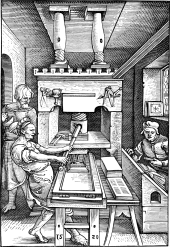
Bookprinting in the 16th century
Print was instrumental in changing the social nature of reading.
Elizabeth Eisenstein identifies 2 long-term effects of the invention of printing. She claims that print created a sustained and uniform reference for knowledge and allowed comparisons of incompatible views.[37]
Asa Briggs and Peter Burke identify 5 kinds of reading that developed in relation to the introduction of print:
- Critical reading: Because texts finally became accessible to the general population, critical reading emerged as people were able to course their own opinions on texts.
- Dangerous reading: Reading was seen as a dangerous pursuit because it was considered rebellious and unsociable, peculiarly in the case of women, because reading could stir upwardly dangerous emotions such as love, and if women could read, they could read love notes.
- Creative reading: Printing immune people to read texts and interpret them creatively, oftentimes in very different ways than the writer intended.
- Extensive reading: In one case print made a wide range of texts bachelor, before habits of intensive reading of texts from start to finish began to modify, and people began reading selected excerpts, assuasive much more than extensive reading on a wider range of topics.
- Private reading: Reading was linked to the rising of individualism because, earlier print, reading was often a group outcome in which 1 person would read to a group. With print, both literacy and the availability of texts increased, and lonely reading became the norm.
The invention of printing besides inverse the occupational structure of European cities. Printers emerged as a new grouping of artisans for whom literacy was essential, while the much more than labour-intensive occupation of the scribe naturally declined. Proof-correcting arose as a new occupation, while a rise in the numbers of booksellers and librarians naturally followed the explosion in the numbers of books.
Educational impact [edit]
Gutenberg'south printing printing had profound impacts on universities too. Universities were influenced in their "language of scholarship, libraries, curriculum, [and] pedagogy" [38]
The language of scholarship [edit]
Before the invention of the press press, most written material was in Latin. However, after the invention of press the number of books printed expanded as well as the vernacular. Latin was not replaced completely, just remained an international linguistic communication until the eighteenth century.[38]
University libraries [edit]
At this time, universities began establishing accompanying libraries. "Cambridge made the chaplain responsible for the library in the fifteenth century merely this position was abolished in 1570 and in 1577 Cambridge established the new office of university librarian. Although, the Academy of Leuven did non meet a need for a university library based on the idea that professor were the library. Libraries also began receiving so many books from gifts and purchases that they began to run out of room. All the same, the event was solved in 1589 past a homo named Merton who decided books should be stored on horizontal shelves rather than lecterns.[38]
Curriculum [edit]
The printed press changed university libraries in many ways. Professors were finally able to compare the opinions of different authors rather than being forced to look at just one or two specific authors. Textbooks themselves were besides beingness printed in unlike levels of difficulty, rather than only 1 introductory text beingness made available.[38]
Comparison of printing methods [edit]
| Printing process | Transfer method | Pressure level practical | Drop size | Dynamic viscosity | Ink thickness on substrate | Notes | Cost-constructive run length |
|---|---|---|---|---|---|---|---|
| Offset printing | rollers | 1 MPa | twoscore–100 Pa·s | 0.5–1.v μm | loftier print quality | > 5,000 (A3 trim size, canvas-fed)[twoscore] > 30,000 (A3 trim size, web-fed)[40] | |
| Rotogravure | rollers | iii MPa | fifty–200 mPa·s | 0.8–8 μm | thick ink layers possible, first-class prototype reproduction, edges of letters and lines are jagged[41] | > 500,000[41] | |
| Flexography | rollers | 0.3 MPa | l–500 mPa·southward | 0.8–2.5 μm | high quality (at present Hd) | ||
| Letterpress printing | platen | x MPa | fifty–150 Pa·s | 0.5–1.5 μm | tedious drying | ||
| Screen-printing | pressing ink through holes in screen | yard–10,000 mPa·s[42] | < 12 μm | versatile method, depression quality | |||
| Electrophotography | electrostatics | 5–10 μm | thick ink | ||||
| Liquid electrophotography | image formation by Electrostatics and transfer while fixing | High PQ, excellent image reproduction, wide range of media, very thin prototype | |||||
| Inkjet printer | thermal | 5–30 picolitres (pl) | one–5 mPa·s[43] | < 0.5 μm | special paper required to reduce bleeding | < 350 (A3 trim size)[forty] | |
| Inkjet printer | piezoelectric | 4–30 pl | v–xx mPa south | < 0.5 μm | special paper required to reduce bleeding | < 350 (A3 trim size)[40] | |
| Inkjet printer | continuous | 5–100 pl | 1–5 mPa·southward | < 0.v μm | special paper required to reduce haemorrhage | < 350 (A3 trim size)[40] | |
| Transfer-impress | thermal transfer film or h2o release decal | mass-production method of applying an image to a curved or uneven surface | |||||
| Aerosol-jet printer | Aerosolized inks carried by gas | ii–5 microns in diameter | 1–1000 mPa s | < one μm | Good printing resolution, High quality[42] [44] |

Digital Printers tin now not just print leaflets and documents, but besides scan, fax, re-create and make booklets plus more than.
Digital printing [edit]
By 2005, digital press accounts for approximately ix% of the 45 trillion pages printed annually around the world.[45]
Printing at dwelling house, an function, or an engineering science environment is subdivided into:
- small-scale format (up to ledger size paper sheets), as used in business organization offices and libraries
- wide format (up to iii' or 914mm broad rolls of paper), equally used in drafting and blueprint establishments.
Some of the more common printing technologies are:
- blueprint – and related chemical technologies
- daisy wheel – where pre-formed characters are applied individually
- dot-matrix – which produces capricious patterns of dots with an array of printing studs
- line printing – where formed characters are applied to the newspaper past lines
- rut transfer – such equally early fax machines or modern receipt printers that apply heat to special paper, which turns black to form the printed prototype
- inkjet – including bubble-jet, where ink is sprayed onto the paper to create the desired image
- electrophotography – where toner is attracted to a charged image and so developed
- light amplification by stimulated emission of radiation – a type of xerography where the charged image is written pixel by pixel using a laser
- solid ink printer – where solid sticks of ink are melted to make liquid ink or toner
Vendors typically stress the total toll to operate the equipment, involving complex calculations that include all cost factors involved in the performance as well every bit the capital letter equipment costs, acquittal, etc. For the most part, toner systems are more economic than inkjet in the long run, even though inkjets are less expensive in the initial purchase price.
Professional digital printing (using toner) primarily uses an electrical charge to transfer toner or liquid ink to the substrate onto which it is printed. Digital print quality has steadily improved from early on color and black and white copiers to sophisticated colour digital presses such as the Xerox iGen3, the Kodak Nexpress, the HP Indigo Digital Press series, and the InfoPrint 5000. The iGen3 and Nexpress use toner particles and the Indigo uses liquid ink. The InfoPrint 5000 is a full-color, continuous forms inkjet drib-on-demand press organisation. All handle variable information, and rival offset in quality. Digital offset presses are also called straight imaging presses, although these presses tin can receive figurer files and automatically turn them into impress-ready plates, they cannot insert variable data.
Small press and fanzines generally use digital printing. Prior to the introduction of cheap photocopying, the use of machines such every bit the spirit duplicator, hectograph, and mimeograph was common.
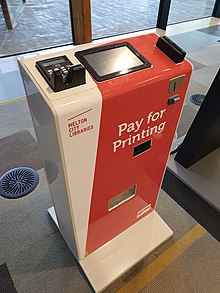
Press payment self service kiosk
3D printing [edit]
3D printing is a form of manufacturing applied science where physical objects are created from iii-dimensional digital models using 3D printers. The objects are created by laying downward or building up many thin layers of material in succession. The technique is as well known equally additive manufacturing, rapid prototyping, or fabricating.[ citation needed ]
Gang run press [edit]
Gang run printing is a method in which multiple press projects are placed on a common paper sail in an attempt to reduce press costs and paper waste. Gang runs are more often than not used with sheet-fed printing presses and CMYK procedure color jobs, which require iv or eight separate plates that are hung on the plate cylinder of the press. Printers use the term "gang run" or "gang" to describe the practice of placing many print projects on the aforementioned oversized sail. Basically, instead of running one postcard that is 4 x 6 as an individual job the printer would identify 15 dissimilar postcards on twenty ten eighteen canvas, therefore using the same amount of press fourth dimension the printer will get 15 jobs done in roughly the same amount of time as one job.
Printed electronics [edit]
Printed electronics is the manufacturing of electronic devices using standard printing processes. Printed electronics engineering can exist produced on cheap materials such as paper or flexible picture show, which makes it an extremely cost-effective method of product. Since early 2010, the printable electronics industry has been gaining momentum and several large companies, including Bemis Company and Illinois Tool Works have made investments in printed electronics and industry associations including OE-A and FlexTech Alliance are contributing heavily to the advancement of the printed electronics industry.[46] [47]
Printing terminologies [edit]
Printing terminologies are the specific terms used in the printing manufacture.
- Airshaft
- Anilox
- Basis weight
- Ben-Day dots
- Bleed (printing)
- Broadsheet
- California Chore Case
- Camera-ready
- Card stock
- Catchword
- CcMmYK color model
- CMYK color model
- Colophon (publishing)
- Color bleeding (printing)
- Composing stick
- Computer to film
- Computer to plate
- Continuous tone
- Dice (philately)
- Dot gain
- Dots per centimeter
- Dots per inch
- Double truck
- Dry out transfer
- Dultgen
- Duotone
- Duplex press
- Edition (printmaking)
- Error diffusion
- Flong
- Foil stamping
- Folio (printing)
- For position simply
- Frisket
- Galley proof
- Gang run printing
- Grammage
- Gray component replacement
- Halftone
- Hand mould
- Hellbox
- Hexachrome
- Hot stamping
- Imposition
- Inkometer
- Iris printer
- Iron-on
- Job Definition Format
- Central plate
- Keyline
- Kodak Proofing Software
- Mezzotint
- Nanotransfer printing
- Non-photo blue
- Overprinting
- Pagination
- Paste up
- Pre-flight (press)
- Prepress
- Prepress proofing
- Press cheque (press)
- Registration black
- Rich black
- Set-off (printing)
- Spot color
- Stochastic screening
- Transfer-print
- Trap (printing)
- Under color removal
See also [edit]
- Color printing
- Cloud printing
- Converters (industry)
- Dickerson combination press
- Electrotyping
- Flexography
- In-mould decoration
- In-mould labelling
- Jang Yeong-sil
- Laurens Janszoon Coster
- Letterpress press
- Music engraving
- Music printing
- Print on demand
- Printed T-shirt
- Press printing cheque
- Security printing
- Textile press
- Waterless printing
- Early on American publishers and printers
References [edit]
- ^ Shelagh Vainker in Anne Farrer (ed), "Caves of the Thousand Buddhas", 1990, British Museum publications, ISBN 0-7141-1447-2
- ^ a b "Great Chinese Inventions". Minnesota-china.com. Archived from the original on December 3, 2010. Retrieved July 29, 2010.
- ^ Rees, Fran. Johannes Gutenberg: Inventor of the Printing Printing
- ^ "Oneline Gallery: Sacred Texts". British Library. Archived from the original on November 10, 2013. Retrieved March 10, 2012.
- ^ Tsuen-Hsuin, Tsien; Needham, Joseph (1985). Paper and Printing. Scientific discipline and Civilisation in China. Vol. v part 1. Cambridge University Press. pp. 158, 201.
- ^ Thomas Franklin Carter, The Invention of Printing in Communist china and its Spread Due west, The Ronald Press, NY 2nd ed. 1955, pp. 176–78
- ^ Mayor, A Hyatt (1980). Prints and People. Vol. v–18. Princeton: Metropolitan Museum of Art. ISBN978-0-691-00326-9.
- ^ Richard W. Bulliet (1987), "Medieval Arabic Tarsh: A Forgotten Chapter in the History of Printing". Journal of the American Oriental Club 107 (3), pp. 427–38.
- ^ Meet Geoffrey Roper, Muslim Press Before Gutenberg and the references cited therein.
- ^ Bloom, Jonathan (2001). Paper Before Print: The History and Impact of Newspaper in the Islamic World . New Haven: Yale University Printing. pp. 8–10, 42–45. ISBN0-300-08955-four.
- ^ Master E.South., Alan Shestack, Philadelphia Museum of Art, 1967
- ^ Beckwith, Christopher I., Empires of the Silk Road: A History of Central Eurasia from the Bronze Age to the Present, Princeton University Press, 2009, ISBN 978-0-691-15034-v
- ^ Tsien 1985, p. 330
- ^ Polenz, Peter von. (1991). Deutsche Sprachgeschichte vom Spätmittelalter bis zur Gegenwart: I. Einführung, Grundbegriffe, Deutsch in der frühbürgerlichen Zeit (in German). New York/Berlin: Gruyter, Walter de GmbH.
- ^ Thomas Christensen (2007). "Did East Asian Press Traditions Influence the European Renaissance?". Arts of Asia Mag (to announced). Retrieved October eighteen, 2006.
- ^ Juan González de Mendoza (1585). Historia de las cosas más notables, ritos y costumbres del gran reyno de la Prc (in Spanish).
- ^ Thomas Franklin Carter, The Invention of Printing in China and its Spread Westward, The Ronald Press, NY 2nd ed. 1955, pp. 176–178
- ^ Fifty. Southward. Stavrianos (1998) [1970]. A Global History: From Prehistory to the 21st Century (seventh ed.). Upper Saddle River, New Jersey: Prentice Hall. ISBN978-0-13-923897-0.
- ^ Briggs, Asa and Burke, Peter (2002) However, more than correctly it should exist described equally the other way around. Gutenberg'southward form of metal movable type was extremely like to the Korean Jikji'south, which was printed 78 years prior to the Gutenberg Bible. A Social History of the Media: from Gutenberg to the Internet, Polity, Cambridge, pp. xv–23, 61–73.
- ^ Gies, Frances and Gies, Joseph (1994) Cathedral, Forge, and Waterwheel: Technology and Invention in the Middle Historic period, New York : HarperCollins, ISBN 0-06-016590-ane, p. 241.
- ^ Steinberg, Southward. H. (1974). Five Hundred Years of Printing (third ed.). Harmondsworth, Middlesex: Penguin. ISBN978-0-14-020343-1.
- ^ Encyclopædia Britannica. Retrieved November 27, 2006, from Encyclopædia Britannica Ultimate Reference Suite DVD – entry "printing"
- ^ Polenz, Peter von. (1991). Deutsche Sprachgeschichte vom Spätmittelalter bis zur Gegenwart: I. Einführung, Grundbegriffe, Deutsch in der frühbürgerlichen Zeit (in German). New York/Berlin: Gruyter, Walter de GmbH.
- ^ In 1997, Time–Life mag picked Gutenberg's invention to exist the almost important of the second millennium. In 1999, the A&East Network voted Johannes Gutenberg "Man of the Millennium". Run into also 1,000 Years, ane,000 People: Ranking The Men and Women Who Shaped The Millennium Archived October 12, 2007, at the Wayback Machine which was equanimous by four prominent US journalists in 1998.
- ^ Pollak, Michael (1972). "The performance of the wooden printing press". The Library Quarterly. 42 (2): 218–64. doi:ten.1086/620028. JSTOR 4306163. S2CID 144726990.
- ^ Bolza 1967, p. 80 harvnb error: no target: CITEREFBolza1967 (assistance)
- ^ Bolza 1967, p. 83 harvnb error: no target: CITEREFBolza1967 (help)
- ^ Bolza 1967, p. 87 harvnb error: no target: CITEREFBolza1967 (help)
- ^ a b Bolza 1967, p. 88 harvnb fault: no target: CITEREFBolza1967 (assistance)
- ^ Joanna Izdebska; Sabu Thomas (September 24, 2015). Printing on Polymers: Fundamentals and Applications. Elsevier Science. p. 199. ISBN978-0-323-37500-9.
- ^ a b Buringh, Eltjo; van Zanden, Jan Luiten: "Charting the 'Rise of the Westward': Manuscripts and Printed Books in Europe, A Long-Term Perspective from the Sixth through Eighteenth Centuries", The Periodical of Economic History, Vol. 69, No. 2 (2009), pp. 409–45 (417, table two)
- ^ a b Ref: Briggs, Asa and Shush, Peter (2002) A Social History of the Media: from Gutenberg to the Cyberspace, Polity, Cambridge, pp. 15–23, 61–73.
- ^ or soon after; Naim A. Güleryüz, Bizans'tan 20. Yüzyıla – Türk Yahudileri, Gözlem Gazetecilik Basın ve Yayın A.Ş., İstanbul, Jan 2012, p. 90 ISBN 978-9944-994-54-5
- ^ Watson, William J., "İbrāhīm Müteferriḳa and Turkish Incunabula", Periodical of the American Oriental Society, 1968, volume 88, outcome 3, p. 436
- ^ "A Lifetime's Collection of Texts in Hebrew, at Sotheby's", Edward Rothstein, New York Times, February eleven, 2009
- ^ a b Meyrowitz: "Mediating Communication: What Happens?" in "Questioning the Media", p. 41.
- ^ Eisenstein in Briggs and Burke, 2002: p. 21
- ^ a b c d Modie, G (2014). "Gutenberg's Furnishings on Universities". History of Education. 43 (4): 17. doi:10.1080/0046760X.2014.930186. S2CID 145093891.
- ^ Kipphan, Helmut (2001). Handbook of print media: technologies and production methods (Illustrated ed.). Springer. pp. 130–44. ISBN978-3-540-67326-2.
- ^ a b c d e Kipphan, Helmut (2001). Handbook of impress media: technologies and production methods (Illustrated ed.). Springer. pp. 976–79. ISBN978-3-540-67326-ii.
- ^ a b Kipphan, Helmut (2001). Handbook of print media: technologies and production methods (Illustrated ed.). Springer. pp. 48–52. ISBN978-iii-540-67326-2.
- ^ a b Zeng, Minxiang; Zhang, Yanliang (October 22, 2019). "Colloidal nanoparticle inks for printing functional devices: emerging trends and future prospects". Journal of Materials Chemistry A. 7 (41): 23301–23336. doi:10.1039/C9TA07552F. ISSN 2050-7496. OSTI 1801277. S2CID 203945576.
- ^ Hu, Guohua; Kang, Joohoon; Ng, Leonard W. T.; Zhu, Xiaoxi; Howe, Richard C. T.; Jones, Christopher G.; Hersam, Mark C.; Hasan, Tawfique (May 8, 2018). "Functional inks and press of ii-dimensional materials". Chemic Lodge Reviews. 47 (nine): 3265–3300. doi:10.1039/C8CS00084K. ISSN 1460-4744. PMID 29667676.
- ^ Paulsen, Jason A.; Renn, Michael; Christenson, Kurt; Plourde, Richard (October 2012). "Printing conformal electronics on 3D structures with Aerosol Jet technology". 2012 Future of Instrumentation International Workshop (FIIW) Proceedings: i–four. doi:10.1109/FIIW.2012.6378343. ISBN978-1-4673-2482-three. S2CID 21924851.
- ^ "When ii% Leads to a Major Industry Shift Archived Feb 16, 2008, at the Wayback Machine" Patrick Scaglia, August xxx, 2007.
- ^ "Recent Announcements Show Gains Existence Made by PE Industry". Printed Electronics Now. Archived from the original on April 7, 2014. Retrieved September 21, 2012.
- ^ "Printable transistors usher in 'net of things'". The Annals . Retrieved September 21, 2012.
Farther reading [edit]
- Edwards, Eiluned (December 2015). Cake Printed Textiles of India. Niyogi Books. ISBN978-93-85285-03-five.
- Elizabeth L. Eisenstein, The Printing Press as an Amanuensis of Change, Cambridge University Press, September 1980, Paperback, 832 p. ISBN 0-521-29955-one
- Gaskell, Philip (1995). A New Introduction to Bibliography. Winchester and Newcastle: St Paul's Bibliographies and Oak Knoll Press.
- Hargrave, J. (2013). Disruptive Technological History: Papermaking to Digital Printing. Journal of Scholarly Publishing, 44(3). 221–227.
- Lafontaine, Gerard S. (1958). Lexicon of Terms Used in the Paper, Printing, and Centrolineal Industries. Toronto: H. Smith Paper Mills. 110 p.
- Marshall McLuhan, The Gutenberg Galaxy: The Making of Typographic Human (1962) Univ. of Toronto Press (1st ed.); reissued by Routledge & Kegan Paul ISBN 0-7100-1818-five
- Nesbitt, Alexander (1957). The History and Technique of Lettering. Dover Books.
- Saunders, Gill; Miles, Rosie (May 1, 2006). Prints Now: Directions and Definitions. Victoria and Albert Museum. ISBN978-ane-85177-480-7.
- Steinberg, Southward.H. (1996). V Hundred Years of Printing. London and Newcastle: The British Library and Oak Knoll Press.
- Tam, Pui-Fly The New Paper Trail, The Wall Street Periodical Online, Feb 13, 2006 p. R8
- Tsien, Tsuen-Hsuin (1985). "Newspaper and Printing". Joseph Needham, Scientific discipline and Civilisation in Red china, Chemistry and Chemical Technology. 5 part 1. Cambridge Academy Press.
- Woong-Jin-Wee-In-Jun-Gi No. 11 Jang Immature Sil by Baek Sauk Gi. 1987 Woongjin Publishing Co., Ltd. p. 61.
On the effects of Gutenberg'due south printing
Early on printers manuals [edit]
The classic manual of early hand-press technology is
- Moxon, Joseph (1962) [1683–1684]. Herbert, Davies; Carter, Harry (eds.). "Mechanick Exercises on the Whole Art of Printing" (reprint ed.). New York: Dover Publications.
- A somewhat later i, showing 18th century developments is
- Stower, Caleb (1965) [1808]. "The Printer'south Grammar" (reprint ed.). London: Gregg Printing.
External links [edit]
| | Look up printing in Wiktionary, the free dictionary. |
| | Wikiquote has quotations related to: Press |
| | Wikimedia Commons has media related to Printing. |
- . Encyclopædia Britannica. Vol. 22 (11th ed.). 1911.
- . New International Encyclopedia. 1905.
- Prints & People: A Social History of Printed Pictures, an exhibition itemize from The Metropolitan Museum of Art (fully available online as PDF)
- Heart for the History of the Volume
- Printing Industries of the Americas – trade association for printers and companies in the graphic arts
- The development of book and printing. English language website of the Gutenberg-Museum Mainz (Germany)
- BPSnet British Printing Society
- Taiwan Culture Portal: Ri Xing Type Foundry – preserving the true character of Chinese type
- A collection of printing materials from the 19th Century – Documents printed by R. Mathison Jr., The Job Printer, in Vancouver, B.C. – UBC Library Digital Collections
- International Press Museum, Carson, CA, Web site
- Museum of Printing, Andover, MA, Web site
- American Printing History Clan, NY, Web site
- Hamilton Wood Type and Printing Museum, WI, Web site
- History of Press – Timeline
lopezgribetwouter48.blogspot.com
Source: https://en.wikipedia.org/wiki/Printing
0 Response to "How to Upload Small Size Photo in Triple C Form and They Are Many More Things Are Printed"
Post a Comment